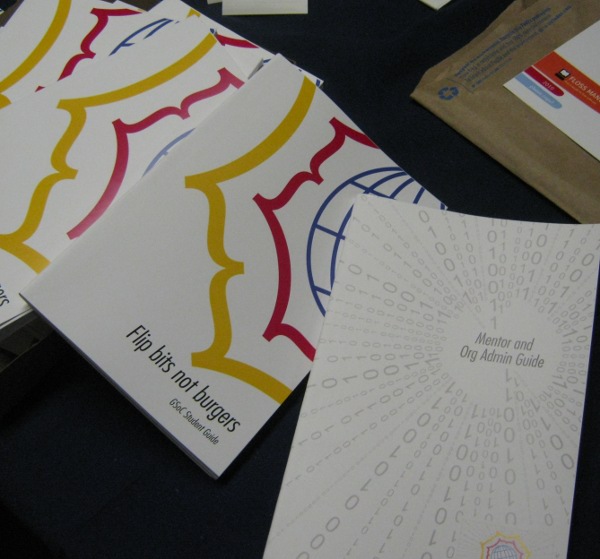I have been experiencing quite a strange phenomenon recently. On several occasions, I have found myself looking for printers that can print perfect bound books quickly. A ‘perfect bound’ book is a book that is normally called a ‘paperback’ – black and white interior colour cover, and a nice thick one piece cover that tightly hugs the outside of the book and is creased and folded along the spine.
 Perfect Bound books printed in less than 20 hours
Perfect Bound books printed in less than 20 hours
I have needed these services after a Book Sprint – typically I have spent 5 days in a room with half a dozen others and we have written a book of 300 pages or so. We output the content to book-formatted PDF with Objavi, and next, to make it a real party, we want to see the book the same day we finished it, or the next morning. It is entirely possible to do this, and I have done it many times. However, the one thing that might catch you out is actually finding the right type of printer that can make perfect bound books fast. This is not easy, and sometimes is made harder if you are in a non-English speaking country as the English term ‘perfect bound’ does not easily translate.
What I have found, is that most large cities have these services. In Berlin, for example, there is a service about 5 blocks away from my house. In Paris, you need to travel out to the suburbs to find a service but there is one. In Palo Alto, Kinkos does it (but doesn’t do it well)…etc….
While these services are relatively common, what I have found, time and time again, is that these services are very hard to find. The first issue is that they have no standard way of marketing their services. It is sometimes advertised as ‘print on demand’, sometimes ‘books on demand’ and sometimes they just don’t let people know they have these services until you ask. Hence trying to find a business that does this via a search engine, a phone book, or asking a local, just gets you nowhere. You have to call every printer one by one, carefully explaining exactly what you want. Sometimes this is also difficult since the operators might not be printers and so they don’t actually know the terminology, and I have found myself trying to explain what ‘perfect binding’ is to a ‘printer’.
The other issue, and this is the one that I find strange and has tripped me up so many times, is that often the locals – printers and non-printers alike – do not think this kind of service exists at all. That is, they think its impossible. This frustrates me the most.
Essentially there are two typical responses from printers that do not provide this kind of service. The first is from your typical ‘copy shop’ – they will tell you they provide these services and then, when you turn up to look at the samples, you find they are talking about spiral or tape binding. Ugh. After explaining this is not ‘perfect binding’ the normal response is a blank stare and a comment that ‘it is not possible’ and furthermore, if they acknowledge that maybe it is possible, the copy shop assistants, not usually knowing the printing industry very well, will have no idea who might be able to do this.
The next kind of response comes from your traditional offset printer. They will tell you they can make a book but you have to get 200 done, it will take a week, and it will cost you a lot per book and expensive set-up costs. When explained that this is not what you want, they will understand what perfect binding is, and they do know the local print industry, but they will not think doing this is possible or have any idea who might be able to give more information about where to find such a service.
I have been through this process many times. My advice is – it can be done. You can find, in most large cities, printers that will print a book in hours and print it cheaply. Recently in Paris, we had 50 books (300 pages) printed for 6 Euros each, no setup costs, and delivered in less than 20 hours. It could have been faster if we had less printed. Often 1 book can be done ‘on the spot’. So don’t give up. It’s perfectly possible to get the job done: the hardest part is finding the people who can do it…



 Perfect Bound books printed in less than 20 hours
Perfect Bound books printed in less than 20 hours